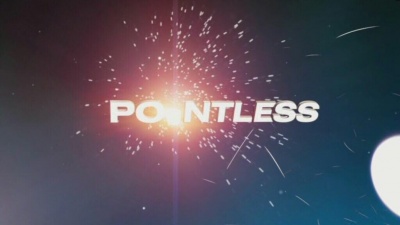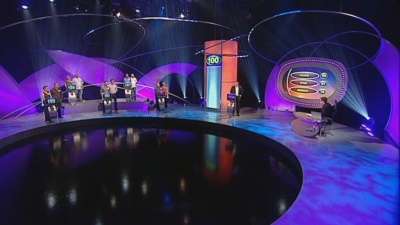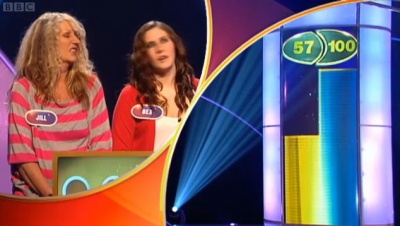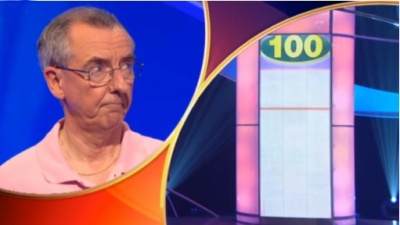Pointless
Contents |
Host
Co-host
Broadcast
Brighter Pictures (an Endemol company) for BBC Two, 24 August to 7 October 2009 (30 episodes in 1 series)
Remarkable Television (an Endemol company) for BBC Two, 8 March 2010 to 15 April 2011 (80 episodes in 2 series, Series 4: 1 to 25 episodes)
Remarkable Television (an Endemol company) for BBC One, 4 July 2011 to present
Synopsis
Cross the surveys of Family Fortunes with the inverse scoring of Beat the Nation and you get... well, you get Topranko!, more or less. Or, if you're BBC Two and pitching for the daytime audience, you get this. If it was us, we probably wouldn't tempt fate (and TV critics) by calling it Pointless, though.
So anyway, Endemol (or rather their appointed agents, specifically market research company Redshift Research) has given 100 people, 100 seconds to name as many things as they can in a given category. These categories are fairly varied, although categories relating to countries and their languages, locations, affiliations etc, do seem to appear far more often than any other category. In the studio, the contestants only have to come up with one answer at a time, and (provided it's a valid answer) they will score points, from zero to 100, depending on how many people gave that answer in the survey. The aim is to give the most obscure answers, and thereby receive the lowest score. Ideally, one would give an answer that nobody gave in the survey - a "pointless" answer - thus scoring nothing at all, and incidentally adding £250 to the jackpot (which starts at £1000 and goes up by £1000 each day it remains unwon). The show's round structure changed considerably from series 1 to series 2, although the basic set-up of asking contestants to guess obscure answers from those provided by 100 surveyed people remained the same.
Series 1
Five pairs start. Each of the first three rounds has the same gameplay: a general category (say, "film" or "politics") is given, to allow each pair to decide which of them will go first in that round. Once the order has been decided, the actual question is given, e.g. "Films directed by Steven Spielberg" or "British Prime Ministers Since 1900" and Richard Osman duly puts the categories in context by confirming exactly what's required and the main source from which the answers are drawn. Alexander Armstrong asks the first player in each pair in turn to give an answer fitting that category; a valid answer scores as outlined above, while an invalid answer scores a penalty of 100 points. After the first player from each pair has given an answer, the second player steps forward to give their answer. The player from the pair who gave their answer last in the first section gives their answer first, the player from the pair who gave their answer fourth in the first section answers second and so on, thereby limiting any unfairness resulting from being the last to answer. Once both players in each pair have answered, the pair with the highest score is eliminated, however each pair is allowed to return for a second and final chance on the next day's show. In the event of a tie-break, each pair must provide another answer, over which they can confer. Each round is treated as a separate contest, with the scores starting afresh from zero each time.
After three rounds, the two surviving pairs play the "head to head" round; the scoring is as before, but now conferring is allowed and encouraged. Also the pair who scored lower over the previous three rounds gets to choose one of two categories. (They also get to choose whether to go first or second, though it seems unlikely that a few seconds' extra thinking time would make up for the disadvantage of always having second "pick", so anyone with their wits about them will choose to go first.) The pairs get an equal number of turns, and the round ends when one or both pairs go over 100 points. The higher-scoring team is eliminated and the other wins the "coveted" Pointless trophy.
The winning team also gets to go for the cash jackpot, which entails picking one of three categories and then giving a Pointless answer to whatever the question is. They are given up to one minute to come up with three answers, however they only need one of them to be Pointless to win the jackpot, but even so it's a very difficult endgame and is rarely won. Oddly, whereas the pairs eliminated earlier in the game can return for second try the next day, the pair who reach the final are not allowed to return the next day, regardless of whether they win or not, and immaterial of whether it is their first time on the show. A problem (which is fixed in series 2) with this section arises from contestants tending to give what they consider their best answer first, which can lead to a bit of an anticlimax if this doesn't win, and their remaining two answers are obviously duds.
Series 2
The first major change is a reduction from 5 pairs of contestants to 4, apparently because the 'banter' between hosts, and between hosts and contestants, proved so popular in series 1 (no, I'm not too sure how they figured that one out, either). Other than this, round one is identical to the first three rounds of the previous series; everyone gets to give one answer each and the highest-scoring pair are knocked out.
Onto round 2, and they start to shake things up a bit. Sort of. The format is identical, but the contestants are presented with a list of seven options to choose from. Each list, we are told, contains at least one pointless answer (oooooh), but at least one incorrect answer as well (booooo). A new list of 7 is presented after the first three contestants have given their answer. Whilst this change is presumably supposed to trick the viewer into thinking there is more variety going on than there really is, it does give them the opportunity to ask slightly harder questions (or questions for which there is no definitive list of all possible correct answers, e.g. "stringed instruments"), as well as to give contestants who have absolutely no idea a chance. (A not too uncommon scenario in the first series would be for a contestant, needing a good answer to stay in, having no idea and either playing it safe or coming up with something ridiculous, neither of which made for particularly exciting telly.) Another result of the change (and you can decide for yourself whether this is a good or bad thing) is that it may be possible to work out which is the pointless answer simply by a process of elimination. As fully-paid-up members of the shout-the-answer-at-the-telly club, we also have to report that picking out a pointless answer from a selection provided, is nowhere near as satisfying a playalong experience as coming up with pointless answers yourself.
After the second set of answers the highest scoring pair are, as usual, shown the door, and we move onto round three, which for those of you who have been paying attention, is the Head to Head.
Here they have made arguably the most improvement. Rather than the single question, to-and-fro, first-to-100-except-not-if-the-other-team-go-over-by-more format of series 1, we have a best-of-5, where each pair gives one answer and the one that scores lower earns a point. This is quite a clever move on several counts. Firstly, we get more questions, which is always a good thing, especially when in the previous series we might have to watch for five or more minutes as contestants gave answers to just one question. It also makes the round much more dramatic. Once both pairs have given their answer, we have a split-screen Pointless-o-meter.
One pair's answer is checked, and one half of the Pointless-o-meter goes down (or turns into an X, as for any other wrong answer). We then swap to the other team and do the same thing. This makes every question at least a little bit exciting; unlike series 1 where either the first few were pretty uninteresting (because no-one was going to get close to 100 for a while), or the game was (pretty much) over immediately when it became apparent that one pair didn't know anything at all about 'pre-1980 BBC Oxford weathermen'. One benefit that must surely have been felt by the researchers, if not by the viewers (and certainly not by the contestants), is that with only two answers being given to any question, there is much more scope for lists with very few members, some examples of which will show up once the series has aired (though one example to get you started is "members of The Famous Five", of which there are, well, five). Although one downside to this is that occasionally they choose a list where many people will know all the answers (such as "words that GNVQ stands for"), in which case the pair that went first will (usually) have a huge advantage.
The team that gets to three points first wins, and goes on to the Pointless final, which remains unchanged, except that contestants are asked to rank their three answers in order of confidence. This cleverly solves the problem of contestants giving their 'best' answer first, which led to some anticlimax in the first series.
Series 3
More changes were afoot in the third series. The second round was changed again, so that instead of a straight list of things in a category, players are now presented with what is essentially a list of trivia questions on a theme - for example, they may be given a list of movie taglines and asked to name the movie, or a list of characters from children's literature and asked to name the book. A wrong answer results in a 100 point penalty, a right answer scores in the usual fashion.
The first round sometimes follows the standard first-round format, and sometimes the old second-round format. The head-to-head round has been reduced to best-of-three, but the jackpot round is unchanged.
Key moments
There was some rather paranoid censorship in the third series - the film titles Austin Powers: The Spy Who Shagged Me and Inglourious Basterds (both incorrect answers to their respective questions) suffered post-production bleeps. You wouldn't get that happening on The Weakest Link.
Catchphrases
"You just didn't have that pointless [subject] knowledge"
(When demonstrating the wrong answer graphics) "You really don't want to see that..."
"It's good! It's very good!"
Theme music
Marc Sylvan
Trivia
During the first series, "Central African Republic" appeared as a pointless answer to four separate questions: "Countries beginning with C", "African countries", "French-speaking countries" and "national flags with stars on". And just to rub it in, its capital Bangui was a pointless answer to "Capital cities beginning with B".
One sharp correspondent noted a bit of a gaffe, or at least an inconsistency, during a round on "Tudor and Stuart Monarchs of Great Britain". Mary, Queen of Scots was ruled to be an incorrect answer, because she was only queen of Scotland ("the clue is in the name," said Richard). However, monarchs of England before the union of the crowns were allowed, so strictly speaking, she should have counted as well (along with a number of other pre-union Scottish monarchs). All of which leads us to ponder how well contestants would fare if faced with the topic of pre-union Scottish monarchs. There's only one way to find out... and we don't mean fight.
The largest amount of money won on the show is £12,250. This amount was won twice in the second series, firstly on 10 March 2010 ("National trails of England and Wales": The Ridgeway), and again on 16 April 2010 ("Countries that use a dollar": Tuvalu).
On the fifth episode of the third series, contestants David and Susan received the unenviable honour of being the first contestants in Pointless history to receive 100 points, but not as a result of giving an incorrect answer. Given a list of possible answers, the contestants had to answer with what type of food they thought each one was. Contestant David answered that Parmesan was a type of cheese and was perfectly correct, however unfortunately for him and his wife Susan, all of the 100 people surveyed also knew it was a type of cheese, meaning they scored 100 points, despite answering correctly. However, thanks to a strong performance from Susan, the couple still managed to win both the round and the show - though not the jackpot.
During the third series, the show was taken off air for a couple of weeks to make way for coverage of the 2010 Commonwealth Games. By a pleasing coincidence, the very first subject when it returned was "Realms of the Commonwealth", which was suddenly very easy for anyone who'd been watching that timeslot. This couldn't have been planned, because the series wasn't even recorded with the intention that it would go out around the time of the Games, but was brought forward as an emergency replacement for the planned show Perfection, which had to be re-shot due to a production error.
The fourth series consisted of 50 episodes, which were shown in two separate runs. The first 25 episodes were shown in Spring 2011 in the usual 4:30pm weekday slot on BBC Two. However when the remaining 25 episodes came to be shown in Summer of the same year, the programme was promoted to the 5:15pm weekday slot on BBC One, home for many years to The Weakest Link, which by that point had already been axed, and was demoted back to BBC Two, taking the slot vacated by Pointless. The first episodes to be shown on BBC One were five celebrity specials, from 4 to 8 July 2011, after which, the remaining episodes from the fourth series were shown.





